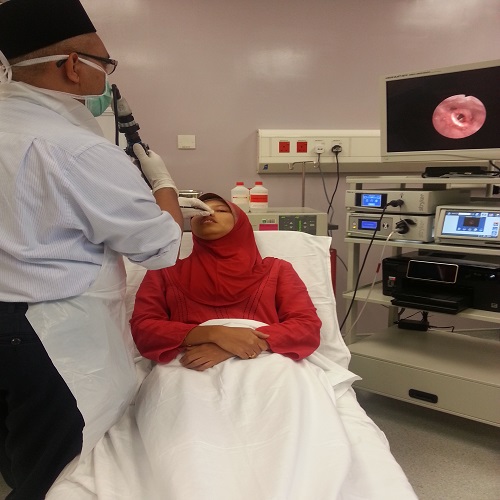Introduction
Voice is a key component in the teaching profession worldwide. This is because the voice is needed during lessons, giving instructions, maintaining discipline and giving guidance to students in the classroom or around the school. A noisy school environment and poor awareness of voice usage and care makes teaching a profession that is at high risk of developing a voice disorder.
What is Voice Disorder?
Voice is said to be disordered when voice quality in aspects of pitch and loudness change from the habitual voice quality. The voice is categorized as disordered when the speaker complains of discomfort or pain during singing or talking (ASHA, 2004).
Roy, Merrill, Thibeault, Parsa, Gray, Smith, (2004), defines voice disorder as voice that is unable to function normally, or voice produced is not the intended voice and subsequently disrupts communication. However, the definition of normal or disordered voice depends on a listener’s own orientation while making the evaluation of another individual’s voice disorder.
Voice disorder is commonly reported among teachers as compared to other professions. Voice disorder affects more female teachers than male teachers. Teachers report that they frequently have voice problems during their teaching career (Kooijman et al., 2007) and 52% of students in the teaching colleges have voice problems during their academic year (Miller & Sloane, 2002).
 |
| Picture: Vocal fold assessment by ENT medical practitioner using a Flexiblescope Source: Unit Terapi Pertuturan HKL, KKM |
Why do teachers frequently have voice disorder?
- Prolong voice usage
- Lack of time for voice recovery
- Exposure to dust and dusty environment
- Need to use a loud voice when teaching
- Classroom environment that has poor acoustics
- Noisy environment in and outside the classroom
- Lack of training on proper voice usage
- Stress/ fatigue/ lack of rest
- Failure to identify symptoms of vocal abuse
- Lack of knowledge/ information or awareness regarding voice use and care
- Lack prevention of vocal abuse
Early Signs of Vocal Fatigue
- Frequently tire easily after talking a lot.
- Frequent sore throat with burning and uncomfortable sensation
- Feeling tension or tightening of throat area when speaking
 |
| Picture: Frequent sore throat |
Symptoms of Vocal Fatigue
- Voice is hoarse/ harsh/ rough/ raspy
- Effortful voicing
- Discomfort when speaking
- Reduced range of pitch and loudness
- Difficulty in raising voice
- Difficulty in controlling voice quality
- Symptoms worsen with frequent use within the day/ week
- Voice becomes better after prolonged rest
When vocal fatigue occurs due to increasing pitch, this will cause an individual to force the muscles around the neck area to work even harder to exert the vocal folds to produce a clearer voice. This ongoing tension will increase severity of voice disorders in teachers.
How to care for your voice?
-
When speaking, make sure that you have good body posture and breath support.
-
Do vocal warm ups before lesson begins.
-
Do not speak in a noisy environment. Speak only after the students have quite down.
-
Reduce shouting in class. Get your students’ attention by using a bell, clapping your hands or tapping/ knocking on the table before giving an instruction.
-
Voice relates very closely to your emotions. Stress/ depression can affect voice quality.
-
Drink plenty of water. Take at least 6-8 glasses/ 2 liters of water per day. It is recommended that you drink also in between lessons because teachers are exposed to dust in the classroom.

Picture: Drink plenty of water
-
Do not smoke/ drink alcohol.
-
Teachers should move in the middle of the class while teaching so that the students at the back of the class can hear you without needing to shout.
-
Speak clearly using a slower rate of speech so that you will not have to repeat the instruction.
-
If your voice is hoarse, don’t whisper.
-
If your voice is hoarse, reduce talking or singing. Rest your voice at least 15 minutes between lessons
-
Use a voice amplifier (microphone)
-
If hoarse voice persists, seek advice from a medical practitioner/ accredited Speech-Language Therapist in the nearest hospital.
References
- Roy, N., Merrill, R. M., Thibeault, S., Parsa, R. a, Gray, S. D. & Smith, E. M. 2004. Prevalence of voice disorders in teachers and the general population. Journal of speech, language, and hearing research?: JSLHR, 47(2), 281–93. doi:10.1044/1092-4388(2004/023)
- Kooijman, P.G.C., Thomas, G., Graamans, K. & de Jong F.I.C.R.S 2007. Psychosocial impact of the teacher’s voice throughout the career. Journal of Voice 21 (3): 316-324
- Sapir, S. & Keidar, A. 1993. Vocal attrition in teachers: Survey finding. European Journal of Disorders of Communication 28 (2): 177-185
- Sala, E., Laine, A., Simberg, S., Pentti, J. & Suonpää, J. 2001. The Prevalence of Voice Disorders Among day care Center Teachers Compared with Nurses: A Questionnaire and Clinical Study. Journal of Voice 15(33): 413-423
- Trial, R. C., Gray, S. D., Dove, H., Corbin-lewis, K. & Stemple, J. C. 2001. An Evaluation of the Effects of Two Treatment Approaches for Teachers With Voice Disorders?: A Prospective (April), 286–296.
- Russell, A., Oates, J., Greenwood, K.M. 1998. Prevalence of Voice Problems in Teachers. Journal of Voice 12(4): 467-479
- Thomas, G., Kooijman, P.G.C., Cremers, C.W.R.J., & de Jong, F.I.C.R.S. 2006. A comparative study of voice complaints and risk factors for voice complaints in female student teachers and practicing teachers early in their career. Eur Arch Otorhinolaryngol 263: 370-380
- http://www.voicecareaustralia.com.au
- www.voicecareforteachers.com
| Last Reviewed | : | 28 August 2020 |
| Writer | : | Rosmah Suriani bt. Mohd Raini |
| Translator | : | Angela Yew Wei Ching |
| Accreditor | : | Fairus bt. Mukhtar |
| Reviewer | : | Nadwah bt. Onwi |







